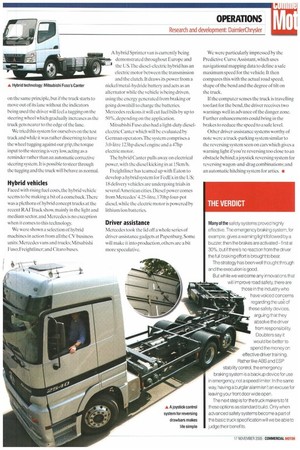LOOKING FORWARD TO SAFETY
Page 60

Page 61

If you've noticed an error in this article please click here to report it so we can fix it.
DaimlerChrysler spends €1 bn a year on CV research and development. Andy Salter visits Mercedes' giant test track in Germany
DaimlerChrysler's position at the head of the global CV sales league is beyond question. But staying there demands constant product development to ensure the vehicles it builds continue to meet the needs of its market. In the pursuit of this, DaimlerChrysler is prepared to invest vast amounts of money —and its at the Papenburg test facility where much of that investment is put through its paces. And so to a wet, windy test track to see where all the money goes.
According to DaimlerChrysler truck engineering boss Gerald Weber, the core factors currently influencing CV development fall into four groups: road congestion; legislation; fuel costs; and customer demands. These four areas cast their shadow over every part of vehicle design and demand specific solutions from the truck manufacturers, be it through improved safety, ever-tighter exhaust emissions,hybrid vehicles or improved operational efficiency. Mercedes was happy to show us some of its solutions to these issues.
Emergency braking
Active safety has been an important part of Mercedes development strategy on its truck line-up, with active cruise control and a lane departure warning system among its more recent innovations.
The next breakthrough on this front will be an emergency braking system which is due for launch next spring.
This initiates emergency braking if there's an acute risk of a head-to-tail collision.one of the most common motorway accidents.While Mercedes admits the new emergency system can't actively prevent accidents, the application of full braking power will at least reduce the impact speed.
Mercedes reports that even if emergency braking is only triggered within 15m of a collision, the impact energy of a truck travelling at 50km/h will be reduced by as much as 95 %.An enhanced version of this system, which will also calculate the level of road grip, is under development to respond more precisely to the driving cc.)nditions.
Lane control
Lane Assistant is already available as an option on the Mercedes truck line-up, although of the 87,000 trucks sold in 2004,only 2,800 were so equipped.At Papenburg we spotted an enhanced version of this system, where the steering intervenes if the driver fails to act.
Currently Lane Assistant is based on a camera system which sounds an alarm if the truck drifts out of lane.The MkII version works on the same principle, but if the truck starts to move out of its lane without the indicators being used the driver will feel a tugging on the steering wheel which gradually increases as the truck gets nearer to the edge of the lane.
We tried this system for ourselves on the test track and while it was rather discerning to have the wheel tugging against our grip, the torque input to the steering is very low, acting as a reminder rather than an automatic corrective steering system. It is possible to steer through the tugging and the truck will behave as normal.
Hybrid vehicles
Faced with rising fuel costs, the hybrid vehicle seems to be making a bit of a comeback.There was a plethora of hybrid concept trucks at the recent RA1Truck show, mainly in the light and medium sector, and Mercedes is no exception when it comes to this technology.
We were shown a selection of hybrid machines in action from all the CV business units: Mercedes vans and trucks: Mitsubishi Fuse; Freightliner; and Ci taro buses. A hybrid Sprinter van is currently being demonstrated throughout Europe and the US.The diesel-electric hybrid has an electric motor between the transmission and the clutch. It draws its power from a nickel/metal-hydride battery and acts as an alternator while the vehicle is being driven, using the energy generated from braking or going downhill to charge the batteries. Mercedes reckons it will cut fuel bills by up to 50%, depending on the application.
Mitsubishi Fuso also had a light-duty dieselelectric Canter which will be evaluated by German operators.The system comprises a 3.0-litre 123hp diesel engine and a 47hp electric motor.
The hybrid Canter pulls away on electrical power, with the diesel kicking in at 5km/h.
Freightliner has teamed up with Eaton to develop a hybrid system for FedEx in the US; 18 delivery vehicles are undergoing trials in several American cities. Diesel power comes from Mercedes' 4.25-litre, 170hp four-pot diesel, while the electric motor is powered by lithium/ion batteries.
Driver assistance
Mercedes took the lid off a whole series of driver-assistance gadgets at Papen burg. Some will make it into production, others are a bit more speculative. We were particularly impressed by the Predictive Curve Assistant, which uses navigational mapping data to define a safe maximum speed for the vehicle. It then compares this with the actual road speed, shape of the bend and the degree of tilt on the truck.
If the computer senses the truck is travelling too fast for the bend, the driver receives two warnings well in advance of the danger zone. Further enhancements could bring in the brakes to reduce the speed to a safe level.
Other driver-assistance systems worthy of note were a truck-parking system similar to the reversing system seen on cars which gives a warning light if you're reversing too close to an obstacle behind; a joystick reversing system for reversing wagon-and-drag combinations; and an automatic hitching system for artics. •






































































































































































































